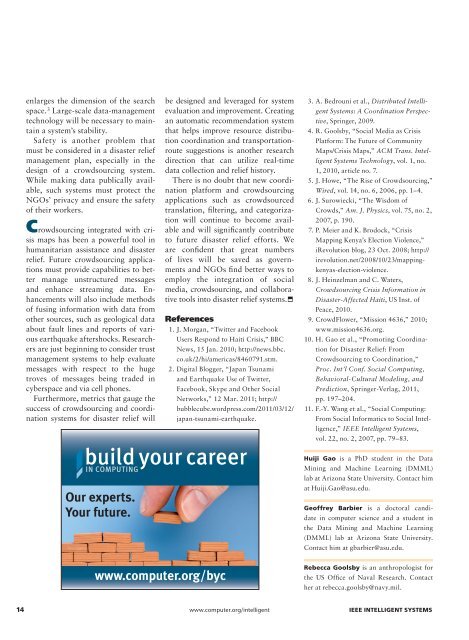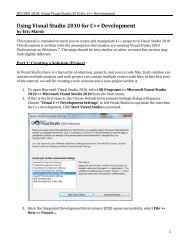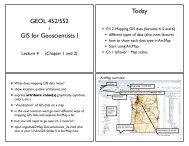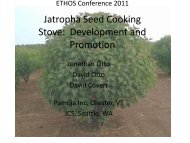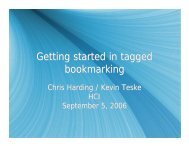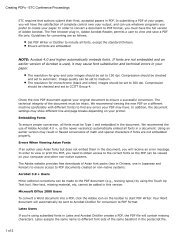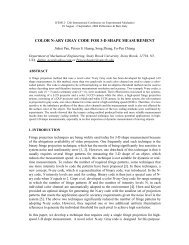Harnessing the Crowdsourcing Power of Social Media for Disaster ...
Harnessing the Crowdsourcing Power of Social Media for Disaster ...
Harnessing the Crowdsourcing Power of Social Media for Disaster ...
- No tags were found...
Create successful ePaper yourself
Turn your PDF publications into a flip-book with our unique Google optimized e-Paper software.
enlarges <strong>the</strong> dimension <strong>of</strong> <strong>the</strong> searchspace. 3 Large-scale data-managementtechnology will be necessary to maintaina system’s stability.Safety is ano<strong>the</strong>r problem thatmust be considered in a disaster reliefmanagement plan, especially in <strong>the</strong>design <strong>of</strong> a crowdsourcing system.While making data publically available,such systems must protect <strong>the</strong>NGOs’ privacy and ensure <strong>the</strong> safety<strong>of</strong> <strong>the</strong>ir workers.<strong>Crowdsourcing</strong> integrated with crisismaps has been a powerful tool inhumanitarian assistance and disasterrelief. Future crowdsourcing applicationsmust provide capabilities to bettermanage unstructured messagesand enhance streaming data. Enhancementswill also include methods<strong>of</strong> fusing in<strong>for</strong>mation with data fromo<strong>the</strong>r sources, such as geological dataabout fault lines and reports <strong>of</strong> variousearthquake aftershocks. Researchersare just beginning to consider trustmanagement systems to help evaluatemessages with respect to <strong>the</strong> hugetroves <strong>of</strong> messages being traded incyberspace and via cell phones.Fur<strong>the</strong>rmore, metrics that gauge <strong>the</strong>success <strong>of</strong> crowdsourcing and coordinationsystems <strong>for</strong> disaster relief willbe designed and leveraged <strong>for</strong> systemevaluation and improvement. Creatingan automatic recommendation systemthat helps improve resource distributioncoordination and transportationroutesuggestions is ano<strong>the</strong>r researchdirection that can utilize real-timedata collection and relief history.There is no doubt that new coordinationplat<strong>for</strong>m and crowdsourcingapplications such as crowdsourcedtranslation, filtering, and categorizationwill continue to become availableand will significantly contributeto future disaster relief ef<strong>for</strong>ts. Weare confident that great numbers<strong>of</strong> lives will be saved as governmentsand NGOs find better ways toemploy <strong>the</strong> integration <strong>of</strong> socialmedia, crowdsourcing, and collaborativetools into disaster relief systems.References1. J. Morgan, “Twitter and FacebookUsers Respond to Haiti Crisis,” BBCNews, 15 Jan. 2010; http://news.bbc.co.uk/2/hi/americas/8460791.stm.2. Digital Blogger, “Japan Tsunamiand Earthquake Use <strong>of</strong> Twitter,Facebook, Skype and O<strong>the</strong>r <strong>Social</strong>Networks,” 12 Mar. 2011; http://bubblecube.wordpress.com/2011/03/12/japan-tsunami-earthquake.3. A. Bedrouni et al., Distributed IntelligentSystems: A Coordination Perspective,Springer, 2009.4. R. Goolsby, “<strong>Social</strong> <strong>Media</strong> as CrisisPlat<strong>for</strong>m: The Future <strong>of</strong> CommunityMaps/Crisis Maps,” ACM Trans. IntelligentSystems Technology, vol. 1, no.1, 2010, article no. 7.5. J. Howe, “The Rise <strong>of</strong> <strong>Crowdsourcing</strong>,”Wired, vol. 14, no. 6, 2006, pp. 1–4.6. J. Surowiecki, “The Wisdom <strong>of</strong>Crowds,” Am. J. Physics, vol. 75, no. 2,2007, p. 190.7. P. Meier and K. Brodock, “CrisisMapping Kenya’s Election Violence,”iRevolution blog, 23 Oct. 2008; http://irevolution.net/2008/10/23/mappingkenyas-election-violence.8. J. Heinzelman and C. Waters,<strong>Crowdsourcing</strong> Crisis In<strong>for</strong>mation in<strong>Disaster</strong>-Affected Haiti, US Inst. <strong>of</strong>Peace, 2010.9. CrowdFlower, “Mission 4636,” 2010;www.mission4636.org.10. H. Gao et al., “Promoting Coordination<strong>for</strong> <strong>Disaster</strong> Relief: From<strong>Crowdsourcing</strong> to Coordination,”Proc. Int’l Conf. <strong>Social</strong> Computing,Behavioral-Cultural Modeling, andPrediction, Springer-Verlag, 2011,pp. 197–204.11. F.-Y. Wang et al., “<strong>Social</strong> Computing:From <strong>Social</strong> In<strong>for</strong>matics to <strong>Social</strong> Intelligence,”IEEE Intelligent Systems,vol. 22, no. 2, 2007, pp. 79–83.Our experts.Your future.Huiji Gao is a PhD student in <strong>the</strong> DataMining and Machine Learning (DMML)lab at Arizona State University. Contact himat Huiji.Gao@asu.edu.Ge<strong>of</strong>frey Barbier is a doctoral candidatein computer science and a student in<strong>the</strong> Data Mining and Machine Learning(DMML) lab at Arizona State University.Contact him at gbarbier@asu.edu.www.computer.org/bycRebecca Goolsby is an anthropologist <strong>for</strong><strong>the</strong> US Office <strong>of</strong> Naval Research. Contac<strong>the</strong>r at rebecca.goolsby@navy.mil.14 www.computer.org/intelligent Ieee INTELLIGenT SYSTemS


